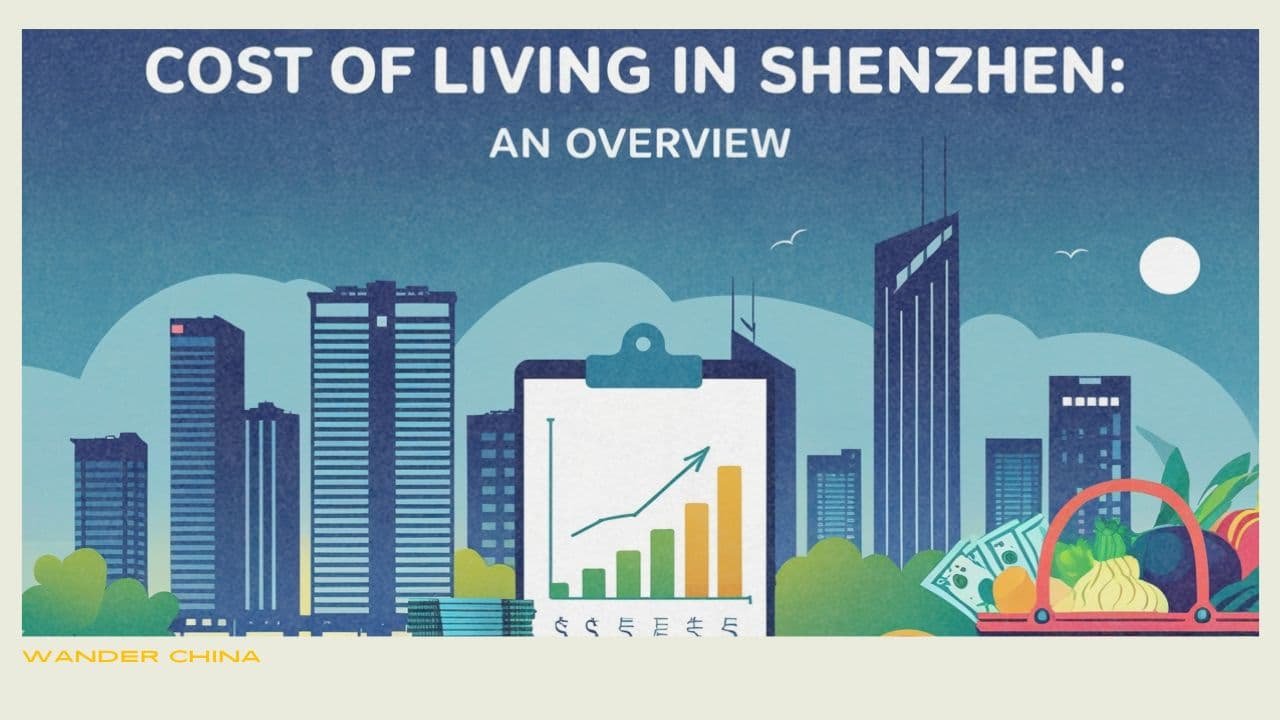The Real Cost of Living in Shenzhen: Tips for Stretching Your RMB
Explore Shenzhen's cost of living for expats: housing, food, entertainment, and transport.

Cost of Living in Shenzhen: An Overview
Shenzhen, a bustling metropolis in southern China, has undergone a remarkable transformation from a sleepy fishing village to a thriving economic powerhouse. As one of the fastest-growing cities in the world, Shenzhen’s cost of living has risen significantly, reflecting its status as a hub for innovation, technology, and business opportunities.
Compared to other major cities in China, such as Beijing and Shanghai, Shenzhen’s cost of living is generally higher. However, it remains relatively affordable when compared to global cities like New York, London, or Tokyo. The city’s strategic location, robust infrastructure, and vibrant job market have attracted a diverse population of locals and expatriates, driving up demand for housing, goods, and services.
Several factors contribute to Shenzhen’s cost of living, including its booming economy, rapid urbanization, and influx of skilled workers. The city’s high-tech industries, such as electronics, telecommunications, and biotechnology, have fueled economic growth and raised income levels. However, this growth has also led to higher prices for necessities like housing, transportation, and healthcare.
Furthermore, Shenzhen’s proximity to Hong Kong and its role as a hub for international trade and investment have influenced its cost of living. The city’s cosmopolitan atmosphere and abundance of luxury goods and services cater to the needs of affluent residents and visitors, driving up prices in certain sectors.
Despite the relatively high cost of living, Shenzhen remains an attractive destination for professionals, entrepreneurs, and investors seeking opportunities in China’s dynamic economic landscape. The city’s vibrant culture, modern amenities, and promising career prospects continue to draw people from across the country and around the world.
Housing Costs in Shenzhen
Housing is one of the most significant expenses for residents in Shenzhen, especially in the city center and popular expatriate areas. Rental prices for apartments can vary greatly depending on factors such as location, size, amenities, and age of the property.
In central areas like Futian and Nanshan districts, where many multinational companies and expatriate communities are located, rent for a one-bedroom apartment can range from ¥5,000 to ¥10,000 per month. Two-bedroom apartments in these prime locations typically cost between ¥8,000 and ¥15,000 per month, while larger three-bedroom units can range from ¥12,000 to ¥25,000 or more.
Prices are generally lower in areas further from the city center, such as Longgang, Bao’an, and Longhua districts. One-bedroom apartments in these areas can be found for ¥3,000 to ¥6,000 per month, while two-bedroom units range from ¥5,000 to ¥10,000, and three-bedroom apartments can cost between ¥8,000 and ¥15,000.
Utility costs, including electricity, water, and internet, can add an additional ¥500 to ¥1,500 per month to the overall housing expenses, depending on the size of the property and usage.
For those interested in purchasing property in Shenzhen, prices can be quite high, especially in prime locations. A one-bedroom apartment in a central area like Futian or Nanshan can cost anywhere from ¥3 million to ¥8 million or more. Two-bedroom units in these areas typically range from ¥5 million to ¥12 million, while larger three-bedroom apartments can cost upwards of ¥10 million.
Property prices are generally lower in suburban areas, but the cost of living in these areas may be offset by longer commute times and fewer amenities nearby. Overall, housing is a significant expense for residents in Shenzhen, and it’s essential to factor in location, size, and amenity preferences when budgeting for accommodation.
Food Expenses in Shenzhen
Food expenses in Shenzhen can vary greatly depending on your lifestyle and preferences. Grocery shopping at local markets and supermarkets can be relatively inexpensive, with fresh produce, meat, and staple items like rice and noodles being quite affordable. A week’s worth of groceries for one person can cost anywhere between ¥200 to ¥500 ($30 to $75), depending on your dietary habits and the quality of the products you choose.
Eating out in Shenzhen offers a wide range of options, from street food stalls to high-end restaurants. Street food is a popular and affordable choice, with dishes like jianbing (savory crepes), chuanr (skewered meats), and baozi (steamed buns) costing between ¥5 to ¥20 ($0.75 to $3). Local eateries and hole-in-the-wall restaurants offer hearty meals for around ¥30 to ¥60 ($4.50 to $9).
For those seeking a more upscale dining experience, Shenzhen has a diverse array of international and fusion restaurants. A meal at a mid-range restaurant can cost between ¥100 to ¥300 ($15 to $45) per person, while fine dining establishments can easily exceed ¥500 ($75) per person.
It’s worth noting that Shenzhen is renowned for its vibrant food scene, and many locals and expats alike enjoy exploring the city’s culinary offerings. From authentic Cantonese cuisine to international flavors, Shenzhen offers a diverse and affordable dining experience for all budgets.
Transportation Costs in Shenzhen
Transportation costs in Shenzhen are relatively affordable, especially when it comes to public transportation. The city has an extensive and efficient public transit system, which includes metro lines, buses, and taxis.
Public Transportation Fares
The Shenzhen Metro is one of the most convenient and cost-effective ways to get around the city. A single-trip ticket costs between ¥2 and ¥8, depending on the distance traveled. Monthly passes are also available, which can significantly reduce the cost for frequent commuters.
Buses in Shenzhen are even more affordable, with fares ranging from ¥1 to ¥4 per trip. Bus routes cover most areas of the city, making them a practical option for short-distance travel.
Cost of Owning a Car
While public transportation is convenient and affordable, some residents may prefer the flexibility of owning a private vehicle. The cost of owning a car in Shenzhen can be substantial, especially when factoring in the purchase price, maintenance, fuel, and parking expenses.
The average cost of a new car in Shenzhen can range from ¥100,000 to ¥300,000 or more, depending on the make and model. Additionally, car owners must pay for annual registration fees, insurance, and regular maintenance.
Fuel costs in Shenzhen are relatively high compared to other parts of China, with gasoline prices averaging around ¥7 per liter. Parking fees can also add up quickly, especially in the city center and popular areas.
Taxi Fares
Taxis are a popular mode of transportation in Shenzhen, especially for shorter distances or when carrying luggage. The base fare for taxis in Shenzhen is ¥10 for the first 3 kilometers, with an additional ¥2.4 per kilometer after that.
During peak hours or late at night, taxi fares may be subject to surcharges. It’s essential to keep in mind that traffic congestion can significantly increase the cost of a taxi ride, especially during rush hours.
Overall, transportation costs in Shenzhen are manageable, particularly for those who rely on public transportation or live in areas well-served by the metro and bus systems. While owning a car can be more expensive, it offers convenience and flexibility for those willing to pay the associated costs.
Healthcare Costs in Shenzhen
Healthcare costs in Shenzhen can vary significantly depending on whether you opt for public or private healthcare services. The city has a well-developed public healthcare system, which is generally more affordable than private healthcare facilities.
For those with a valid residence permit and enrolled in the public health insurance scheme, the costs of medical services at public hospitals and clinics are heavily subsidized. Basic consultations and treatments can cost as little as ¥20-50 (around $3-8), while more complex procedures and surgeries may range from a few hundred to a few thousand yuan.
Private healthcare facilities, on the other hand, offer more modern amenities, shorter waiting times, and English-speaking staff, but at a premium cost. A basic consultation at a private clinic can cost anywhere from ¥300-800 ($45-120), while more specialized treatments and surgeries can easily run into the tens of thousands of yuan.
Health insurance premiums also vary widely depending on the coverage and provider. Basic public health insurance plans for locals can cost around ¥300-500 ($45-75) per year, while comprehensive international health insurance plans for expats can range from ¥10,000-30,000 ($1,500-4,500) or more annually.
Medication expenses can also add up, especially for chronic conditions or specialized drugs. While generic drugs at public hospitals are relatively inexpensive, branded medications and imported drugs from private pharmacies can be costly, often running into hundreds or thousands of yuan per month.
Overall, healthcare costs in Shenzhen can be manageable for those utilizing the public healthcare system and insurance schemes. However, for those seeking private healthcare or without adequate insurance coverage, the costs can quickly become a significant financial burden.
Education Costs in Shenzhen
Education costs in Shenzhen can vary widely depending on the type of school and the level of education. For international families or those seeking a more global curriculum, international schools are a popular choice, but they come with a hefty price tag.
Tuition Fees for International Schools
International schools in Shenzhen offer a curriculum based on foreign education systems, such as American, British, or International Baccalaureate (IB). These schools typically provide a high-quality education with small class sizes, modern facilities, and a diverse student body. However, the tuition fees for international schools in Shenzhen can range from ¥100,000 to ¥300,000 (approximately $15,000 to $45,000) per year, depending on the grade level and the school’s reputation.
Local Schools
For families on a tighter budget or those seeking a more immersive cultural experience, local public schools in Shenzhen offer a more affordable option. Tuition fees for local public schools are relatively low, ranging from ¥2,000 to ¥5,000 (approximately $300 to $750) per year. However, these schools primarily teach in Mandarin Chinese, which can be challenging for non-native speakers.
Higher Education
Shenzhen is home to several universities and colleges, both public and private. Tuition fees for higher education institutions in Shenzhen can vary significantly depending on the institution and the program of study. Public universities typically have lower tuition fees, ranging from ¥5,000 to ¥20,000 (approximately $750 to $3,000) per year for undergraduate programs. Private universities, on the other hand, can charge significantly higher tuition fees, sometimes exceeding ¥100,000 (approximately $15,000) per year for certain programs.
It’s important to note that in addition to tuition fees, families should also factor in additional costs such as registration fees, textbooks, transportation, and extracurricular activities when budgeting for education expenses in Shenzhen.
Entertainment and Leisure Costs in Shenzhen
Shenzhen offers a vibrant entertainment and leisure scene, catering to diverse interests and budgets. Whether you’re a movie buff, sports enthusiast, fitness fanatic, or a nightlife connoisseur, the city has something to offer for everyone.
Movies: Catching the latest blockbuster or indie flick is a popular pastime in Shenzhen. Ticket prices for standard 2D movies range from ¥30 to ¥60 ($4.50 to $9) at most cinemas. For premium experiences like 3D or IMAX screenings, prices can go up to ¥100 ($15) or more.
Sports Events: Shenzhen is home to several professional sports teams, including the Shenzhen FC (football/soccer) and the Shenzhen Aviators (basketball). Ticket prices for these events can vary greatly depending on the sport, event, and seating category. Generally, expect to pay anywhere from ¥50 ($7.50) for basic seating to ¥500 ($75) or more for premium seats.
Gym Memberships: Staying fit is a priority for many residents in Shenzhen. Monthly gym memberships can range from ¥200 to ¥800 ($30 to $120), depending on the facility and amenities offered. High-end gyms with state-of-the-art equipment, pools, and specialized classes can cost upwards of ¥1,000 ($150) per month.
Nightlife: Shenzhen’s nightlife scene is vibrant and diverse, offering everything from trendy rooftop bars to lively clubs and karaoke lounges. The cost of a night out can vary significantly depending on your preferences and the venue. A cocktail at a mid-range bar can cost around ¥60 to ¥100 ($9 to $15), while entry fees for clubs can range from ¥100 to ¥300 ($15 to $45), with higher prices for special events or popular venues.
It’s worth noting that many entertainment and leisure activities in Shenzhen can be enjoyed on a budget by taking advantage of discounts, promotions, and seeking out local hotspots frequented by residents. Additionally, the city’s vibrant street food scene and public parks offer affordable and enjoyable alternatives for leisure time.
Clothing and Personal Care Costs in Shenzhen
Living in Shenzhen, one of China’s most modern and cosmopolitan cities, comes with a range of expenses, including those related to clothing and personal care. While Shenzhen may not be as expensive as some other major cities in China, these costs can still add up and impact your overall budget.
When it comes to clothing, Shenzhen offers a diverse array of options, from high-end designer brands to more affordable local and international retailers. For those seeking designer labels, prices can be relatively steep, with a men’s suit costing anywhere from ¥2,000 to ¥10,000 or more, depending on the brand and quality. However, for more budget-conscious shoppers, popular local brands like Uniqlo, H&M, and Zara offer stylish and affordable options, with prices ranging from ¥100 to ¥500 for basic clothing items.
Shenzhen is also home to numerous markets and shopping districts, where bargaining is expected and prices can be significantly lower than in malls or boutiques. The Luohu Commercial City, for instance, is a massive market known for its vast selection of clothing, accessories, and household items at incredibly low prices, often starting from just a few yuan.
When it comes to personal care services, Shenzhen offers a wide range of options at varying price points. A basic haircut at a local barbershop or salon can cost anywhere from ¥30 to ¥100, while more upscale establishments may charge ¥200 or more for a cut and style. Grooming services like manicures and pedicures are also widely available, with prices ranging from ¥50 to ¥200, depending on the location and quality of the service.
For those seeking more specialized services, such as massages or spa treatments, Shenzhen has a thriving wellness industry catering to both locals and visitors. Prices for these services can vary greatly, with basic massages starting around ¥100 for an hour, while luxury spa packages can easily cost upwards of ¥1,000 or more.
Overall, Shenzhen offers a diverse range of clothing and personal care options to suit various budgets and preferences. By exploring local markets, taking advantage of sales and promotions, and being mindful of your spending, it is possible to maintain a stylish and well-groomed lifestyle without breaking the bank.
Cost of Living for Expats in Shenzhen
Living in Shenzhen as an expatriate can be an exciting experience, but it’s essential to understand the associated costs. Expats often face additional expenses that locals may not encounter, such as higher housing costs, international school fees, and import taxes on personal belongings.
Housing Costs for Expats
Expats in Shenzhen typically opt for modern apartments or villas in expat-friendly neighborhoods like Shekou, Futian, and Nanshan. These areas offer a higher standard of living and amenities catering to Western lifestyles. However, the rent for these accommodations can be significantly higher than local housing options, with prices ranging from $1,500 to $5,000 per month for a two-bedroom apartment.
International School Fees
One of the most significant expenses for expat families in Shenzhen is international school tuition. International schools offer curricula and teaching methods familiar to expats, but their fees can be substantial. Annual tuition fees for international schools in Shenzhen can range from $15,000 to $35,000 or more, depending on the school’s reputation and curriculum.
Import Costs and Taxes
Expats relocating to Shenzhen often need to import personal belongings, furniture, and household goods. This process can incur additional costs, such as import duties, taxes, and shipping fees. The import taxes in China can be high, ranging from 10% to 25% of the declared value of the imported items.
Other Expat Expenses
In addition to housing, education, and import costs, expats in Shenzhen may also face higher expenses for certain goods and services compared to locals. These can include:
- Imported food and beverages from Western countries
- Memberships at expat clubs and organizations
- International healthcare plans and private medical services
- Domestic help and housekeeping services
- International travel and flights back home
Overall, while Shenzhen offers a relatively affordable cost of living compared to other major cities in China, expats should be prepared for additional expenses related to their lifestyle and specific needs. Proper budgeting and research are crucial to ensure a comfortable and financially stable life as an expat in Shenzhen.
Cost of Living Index and Comparison
Shenzhen consistently ranks among the most expensive cities in the world for cost of living. According to the Mercer Cost of Living Survey 2022, Shenzhen is the 7th most expensive city globally, surpassing cities like New York, Singapore, and London. The Economist Intelligence Unit’s Worldwide Cost of Living Survey 2022 places Shenzhen at the 21st spot, making it one of the priciest cities in Asia.
When compared to other major Chinese cities, Shenzhen’s cost of living is significantly higher. The Numbeo Cost of Living Index puts Shenzhen at the top, with an index score of 77.96, followed by Shanghai (72.76), Beijing (70.95), and Guangzhou (65.89). This stark difference is primarily due to Shenzhen’s booming tech industry, high housing costs, and growing expatriate population.
Shenzhen’s cost of living is also higher than many other major global cities. For instance, the Numbeo Index ranks Shenzhen above cities like Los Angeles (73.54), Sydney (72.46), and Tokyo (71.89). However, it remains lower than notoriously expensive cities like New York (100), San Francisco (96.45), and Hong Kong (83.49).
The high cost of living in Shenzhen is a double-edged sword. While it reflects the city’s economic prosperity and attractiveness for businesses and talent, it also poses challenges for residents, especially those with lower incomes. Nonetheless, Shenzhen’s ranking on global indices underscores its status as a major international hub and a sought-after destination for expats and professionals.
Money-Saving Tips for Living in Shenzhen
Living in Shenzhen can be expensive, but with some smart strategies and budgeting techniques, you can reduce your expenses and make your money go further. Here are some practical money-saving tips for living in Shenzhen:
Rent a Shared Apartment or Room
One of the biggest expenses in Shenzhen is housing. To save on rent, consider sharing an apartment or renting a room in a shared flat. This can significantly reduce your monthly housing costs, and it’s a popular option among students and young professionals.
Cook at Home and Avoid Eating Out
Eating out frequently can quickly drain your budget. Instead, cook your meals at home and pack your lunch for work or school. Shenzhen has numerous markets and grocery stores where you can find fresh and affordable ingredients. Cooking at home not only saves money but also allows you to control your diet and eat healthier.
Use Public Transportation
Shenzhen has an efficient and extensive public transportation system, including metro lines, buses, and shared bicycles. Using public transportation instead of owning a car or taking taxis can save you a significant amount of money on transportation costs.
Explore Free or Low-Cost Entertainment Options
Shenzhen offers plenty of free or low-cost entertainment options, such as parks, museums, and cultural events. Take advantage of these opportunities to enjoy your leisure time without breaking the bank. Additionally, look for discounts or special offers on activities and attractions.
Buy Second-hand or Seek Out Bargains
When it comes to clothing, furniture, or household items, consider buying second-hand or seeking out bargains. Shenzhen has numerous markets and online platforms where you can find gently used items at a fraction of the cost of buying new.
Negotiate and Compare Prices
In Shenzhen, it’s common to negotiate prices, especially in markets and with service providers. Don’t be afraid to haggle or compare prices from different vendors to get the best deal. This practice can save you a significant amount of money over time.
Create a Budget and Track Your Expenses
Developing a realistic budget and tracking your expenses is crucial for managing your finances effectively. Use budgeting apps or spreadsheets to monitor your spending patterns and identify areas where you can cut back or make adjustments.
By implementing these money-saving tips, you can enjoy a comfortable lifestyle in Shenzhen while keeping your expenses under control. Remember, being mindful of your spending habits and making smart financial choices can go a long way in reducing your cost of living in this vibrant city.
Future Trends and Predictions
Shenzhen’s cost of living is expected to continue rising in the coming years, driven by various economic factors and the city’s growing prominence. The real estate market is projected to see steady growth, with housing prices and rental rates likely to increase further, especially in prime areas and newly developed neighborhoods.
The city’s rapidly expanding tech industry and influx of talented professionals will contribute to the rising cost of living. As more companies establish their presence in Shenzhen, the demand for housing, goods, and services will surge, leading to potential price hikes across various sectors.
Additionally, the ongoing urbanization and infrastructure development projects in Shenzhen will likely impact the cost of living. New transportation links, improved amenities, and the creation of smart city initiatives may drive up prices in certain areas, making them more desirable and expensive for residents.
However, the local government’s efforts to control housing prices and promote affordable living options could potentially counterbalance some of the cost increases. Policies aimed at regulating the real estate market and providing subsidized housing for low-income residents may help mitigate the impact on the overall cost of living.
Furthermore, the city’s continued economic growth and rising incomes may offset some of the cost increases, making Shenzhen more affordable for its residents. As salaries and disposable incomes rise, the relative burden of living expenses may become more manageable for many households.
It’s crucial to monitor the interplay of these factors and the government’s initiatives to gauge the future cost of living trends in Shenzhen accurately.
Final Thoughts and Conclusions
Shenzhen’s cost of living can be considered relatively high compared to other Chinese cities, but it remains more affordable than many major global cities. Housing and transportation are the biggest expenses, while food and entertainment can be quite reasonable with a bit of budgeting.
Overall, Shenzhen offers a good balance between quality of life and cost of living for those earning a decent income. Expats and middle-class locals can enjoy a comfortable lifestyle, though it may require some financial planning and cost-consciousness.
The city’s rapid development and increasing popularity as a tech and innovation hub suggest that costs could continue rising in the coming years. However, salaries and economic opportunities are also expected to grow, potentially offsetting some of the increased expenses.
Ultimately, Shenzhen’s cost of living is manageable for those prepared to adapt their spending habits and prioritize their expenses. With its vibrant economy, modern amenities, and proximity to natural attractions, the city can be an attractive option for those seeking an exciting urban lifestyle at a relatively reasonable cost compared to other major global cities.
Recent Posts
- Guangzhou Garment Wholesale Markets: My Local Guide
- Best Hotel in Guangzhou: A Comprehensive Guide for Foreign Travelers
- Guangzhou Food Guide: Must-Try Dishes & Top Restaurants (2025 Edition)
- Top Outlet Malls in Guangzhou: My Ultimate 2025 Shopping Guide
- Arts and Crafts Wholesale Markets in Guangzhou
Recent Comments
Best Hotel in Guangzhou: A Comprehensive Guide for Foreign Travelers
Find the best hotels in Guangzhou—from luxury icons to local favorites. Updated...
Guangzhou Food Guide: Must-Try Dishes & Top Restaurants (2025 Edition)
I’m an expat in Guangzhou sharing the best local dishes, top restaurants...
Top Outlet Malls in Guangzhou: My Ultimate 2025 Shopping Guide
I explored Guangzhou’s best outlet malls—real deals, top brands, and local tips...
Arts and Crafts Wholesale Markets in Guangzhou
Discover Guangzhou’s top arts & crafts wholesale markets, from Yide Road to...







Leave a comment